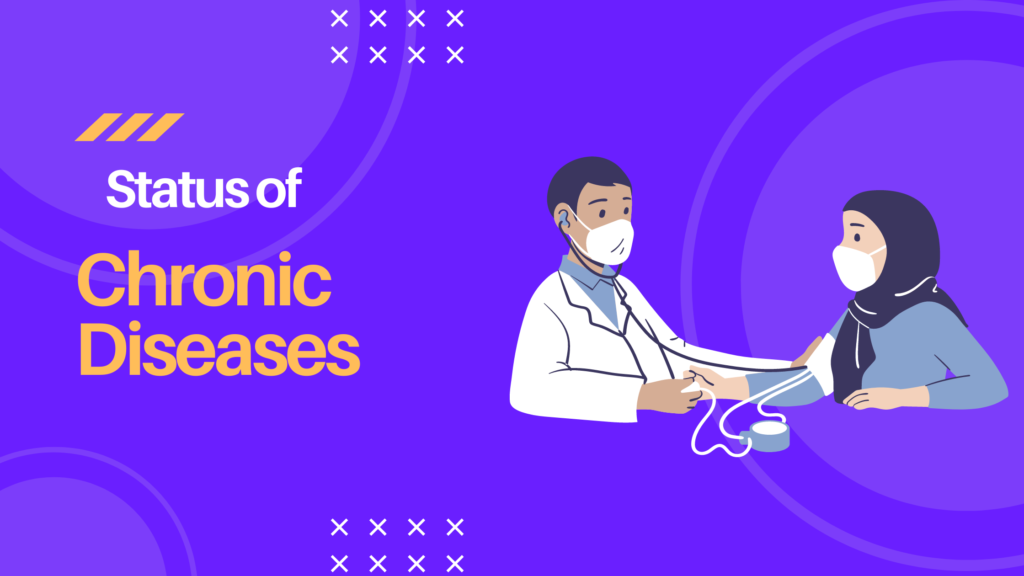Table of Contents
Introduction
The current status of chronic diseases, global, USA and India are discussed in this blog article. These diseases are increasing everywhere, main reason being the treatment methods adopted to control the rise of these diseases, managing the diseases and not treating the underlying cause of diseases. This trend will continue to rise until we think differently from behavioral risk factors of chronic diseases to the root cause.
Global Status of Chronic Diseases

Chronic diseases are long-lasting conditions that typically progress slowly. The World Health Organization (WHO) identifies four main types of chronic diseases: cardiovascular diseases (such as heart attacks and stroke), cancer, chronic respiratory diseases (such as chronic obstructive pulmonary disease and asthma), and diabetes.
Chronic diseases are the leading cause of death in the world, accounting for over 60% of all annual deaths. In 2008, 36 million deaths were due to chronic diseases, comprising mainly cardiovascular diseases, diabetes, chronic lung diseases, and cancers. About one-fourth of global chronic disease-related deaths took place before the age of 60 years. Some 80% of all chronic disease deaths occurred in low- and middle-income countries.
Diabetes is a significant public health problem worldwide, causing death and disability at a great economic cost. Despite the need for quality diabetes care to prevent long-term complications, care often falls below recommended standards.[ https://apps.who.int/iris/bitstream/handle/10665/42792/9241580348_eng_Volume1.pdf] Cardiovascular disease (CVD) is the leading cause of death worldwide, accounting for approximately 18 million deaths a year. CVD is also the leading cause of mortality in developing countries. In developing countries, mortality from ischemic heart disease is expected to increase by 120% for women and 137% for men.[ref: A race against time: the challenge of cardiovascular disease in developing economies – https://www.eldis.org/document/A18750]
Respiratory diseases, including asthma and chronic obstructive pulmonary disease (COPD), caused 4.2 million deaths in 2008, and 90% of deaths occurred in low and middle-income countries.[ref:
Ezzati M, Lopez A. D, Rodgers A, Murray C. J. L. Geneva: World Health Organization; 2005. Comparative quantification of health risks: global and regional burden of diseases attributable to selected major risk factors.: https://apps.who.int/iris/handle/10665/42770]
The World Health Organization estimates that there will be a significant economic impact on chronic diseases worldwide. In 2005, the estimated loss in national income from heart disease, stroke, and diabetes was 18 billion dollars in China, 11 billion dollars in Russian Federation, 9 billion dollars in India, and 2.7 billion dollars in Brazil. Similarly, the losses for the UK, Pakistan, Canada, Nigeria, and the United Republic of Tanzania were 1.6 billion dollars, 1.2 billion dollars, 0.53 billion dollars, 0.4 billion dollars, and 0.1 billion dollars respectively. Three-quarters of health care expenditure in the United States is on chronic disease bills (US $ 1-7 trillion per year).
The burden of chronic diseases poses appreciably greater constraints to economic performance in low and middle-income countries. The estimates do not include the lifetime cost of morbidity, disabilities, and foregone expected lifetime earnings of individuals. [Ref: An Overview of Chronic Disease Models: A Systematic Literature Review https://www.ncbi.nlm.nih.gov/pmc/articles/PMC4796376/]
Current Status of Chronic Diseases in the USA
The prevalence of chronic diseases is increasing in the United States, across all age groups, especially in aged people. This is due to a number of factors, including an aging population, unhealthy lifestyles, and environmental factors.
If there were a cure, I mean a real cure, the situation would have been different. There is no cure. Therefore, as the population of aged people increases, so does the increase in the number of people suffering from chronic disease. The policymakers think about managing the disease and not curing the disease.
People in the USA are used to eating processed food, rather than cooking fresh food every day. Additionally, many people in the USA regularly smoke and consume alcohol. These habits deplete the body of essential nutrients, making them more prone to diseases.
The monetary cost of chronic diseases is also rising. Medical care, drugs, and other therapies are becoming more expensive. In the USA alternative holistic methods are rarely used to improve health. Even if people consider food as medicine, and start consuming more fruits and vegetables, the number of people suffering from chronic diseases can go down.
In addition, chronic diseases have indirect costs such as lost production and incapacity. The ability of the diseased person to perform the work goes down. Many times he or she may have to be hospitalized for medical care.
For those with poor incomes, the burden of chronic diseases is disproportionately great. These people are more likely to suffer chronic illnesses and have limited access to high-quality medical treatment.
Multiple chronic conditions (MCCs) are a growing problem in the United States. MCCs are defined as two or more chronic conditions that a person has at the same time. Nearly one in four adults in the United States (131 million) has MCCs.
The most common chronic diseases in the United States are heart disease, cancer, stroke, type 2 diabetes, arthritis, osteoporosis, asthma, chronic obstructive pulmonary disease (COPD), and chronic kidney disease. These diseases account for half of all deaths in the United States.
The financial burden of chronic diseases is significant. In 2019, the cost of chronic diseases was estimated to be $3.8 trillion, including $1.2 trillion in direct medical costs and $2.6 trillion in indirect costs such as lost productivity. [ref:Chronic Disease in the United States: A Worsening Health and Economic Crisis; Tara O’Neill Hayes, Serena Gillian:https://www.americanactionforum.org/research/chronic-disease-in-the-united-states-a-worsening-health-and-economic-crisis/#ixzz873zeebc2]
The burden of NCDs and their risk factors in India
(Excerpted from Global Status Report on NCDs -2014)
Noncommunicable (Chronic) diseases (NCDs) account for 60% of all deaths in India. The four leading causes of NCD death are cardiovascular disease, stroke, and hypertension (45%). Chronic respiratory disease (22%) is the most common, followed by cancer (12%) and diabetes (3%).[Ref: ref: Chronic Diseases in India—Ubiquitous Across the Socioeconomic Spectrum; Shivani A. Patel et al https://jamanetwork.com/journals/jamanetworkopen/fullarticle/2729795
It is worth noting the burden of chronic diseases (NCDs) and their risk factors in India reported in WHO report in 2014.[ Ref: https://www.who.int/docs/default-source/searo/india/health-topic-pdf/noncommunicable-diseases/ncd-situation-global-report-ncds-2014.pdf?sfvrsn=ee0a9307_2]
- Non-communicable diseases (NCDs) contribute to around 5.87 million deaths which account for 60 % of all deaths in India. India shares more than two-thirds of the total deaths due to NCDs in the South-East Asia Region (SEAR) of WHO.
- Four types of NCDs—cardiovascular diseases, cancer, chronic respiratory diseases, and diabetes make the largest contribution to morbidity and mortality due to NCDs. Four behavioral risk factors are responsible for significant proportions of these diseases—tobacco use, unhealthy diet, physical inactivity, and harmful use of alcohol. Major metabolic risk factors are obesity, raised blood pressure, raised blood glucose, and raised blood total cholesterol levels.
- Cardiovascular diseases (coronary heart disease, stroke, and hypertension) contribute to 45% of all NCD deaths followed by chronic respiratory disease (22 %), cancers (12 %), and diabetes (3%).
- The probability of dying between ages 30 and 70 years from four major NCDs is 26%, which means that a 30-year-old individual has a one-fourth chance of dying from these diseases before the age of 70 years.
- The prevalence of current tobacco smoking has shown a slight decline in males but the prevalence (23.6%) is still higher than the global prevalence of current tobacco smoking (22%). Tobacco use has been identified as the single largest risk factor attributable to NCDs.
- The prevalence of obesity and overweight is also showing a rapid increase in trends. Age-standardized prevalence of obesity (BMI≥ 30) has increased by 22 % in the span of four years (2010-2014).
- Nearly one out of every ten persons aged 18 years and above in India has raised blood glucose, which poses an extra financial and service burden on health systems. The age-standardized prevalence of raised blood glucose is 9.0 % for both sexes.
- Every fourth individual in India aged above 18 years has raised blood pressure (hypertension) and the prevalence has increased by 10% from 2010 to 2014.
- The per capita consumption of pure alcohol (age +15) in India is estimated to be 5.2 liters per year. In 2010, the corresponding figure was 4.3 liters per year, which was significantly higher than the average consumption in the SEAR. (3.2 liters per year).
- More than two-thirds of the adolescents aged 11-17 years are physically inactive in India as per WHO standards. The level of physical inactivity among adults is around 13 %.

